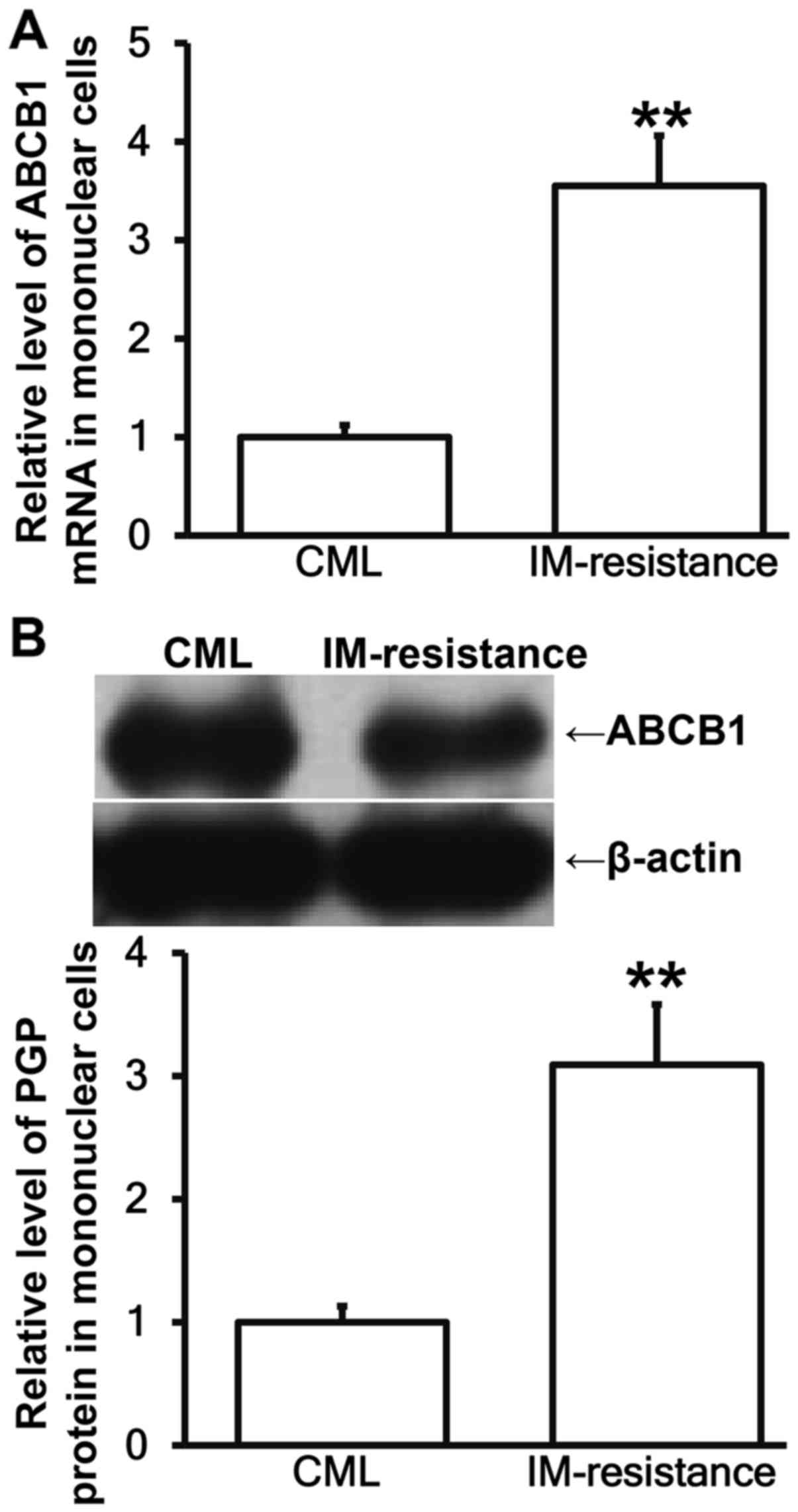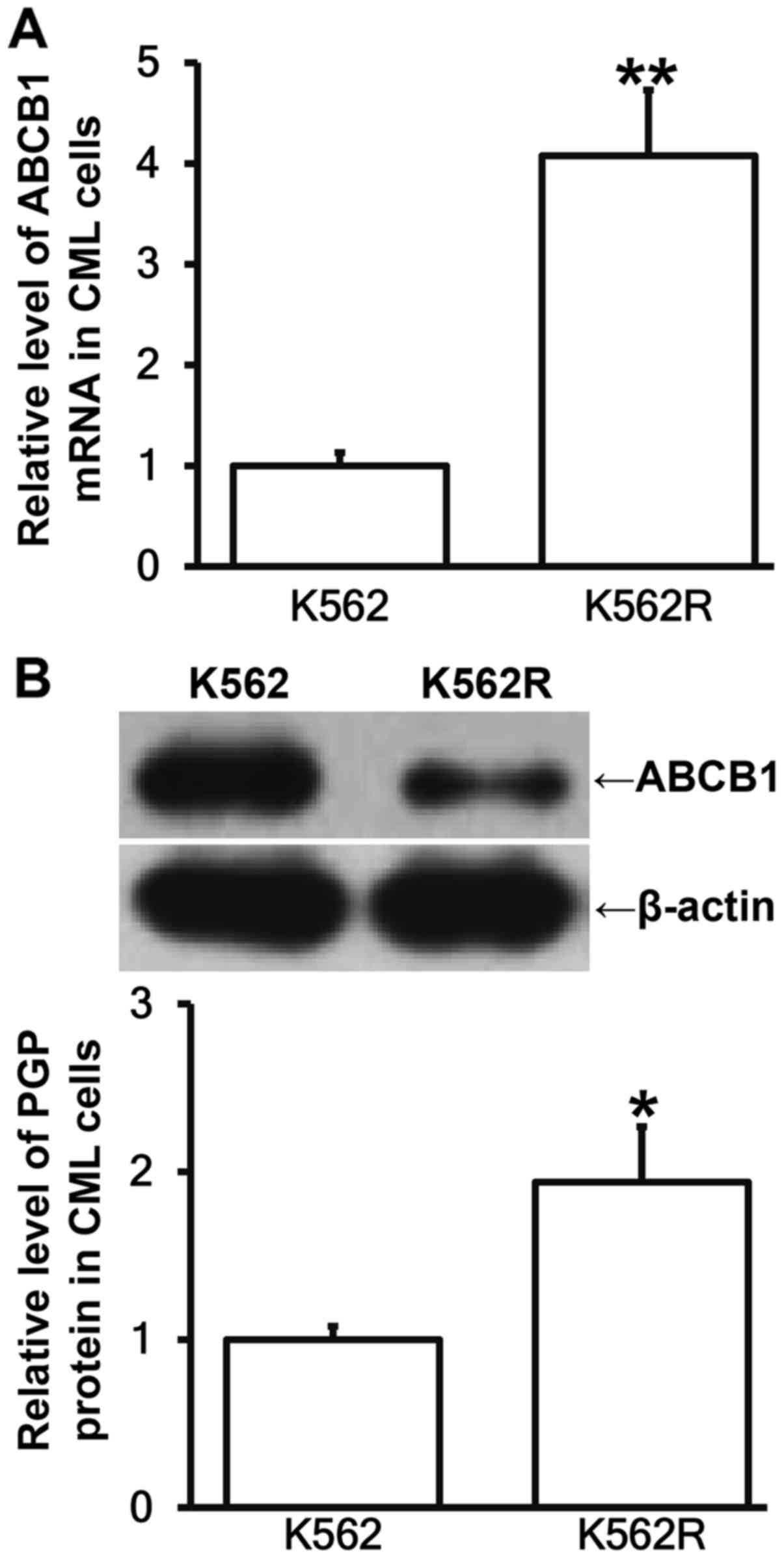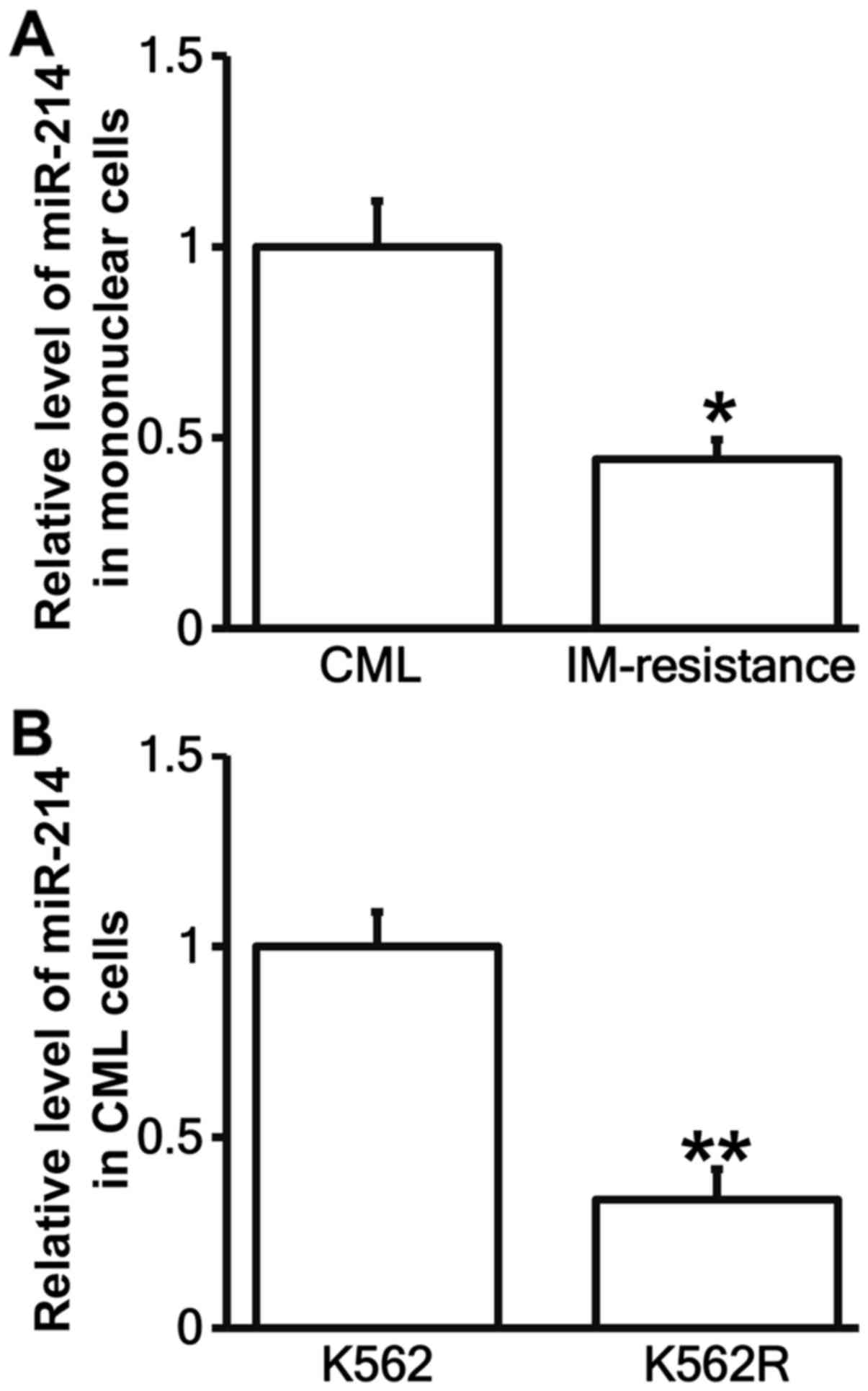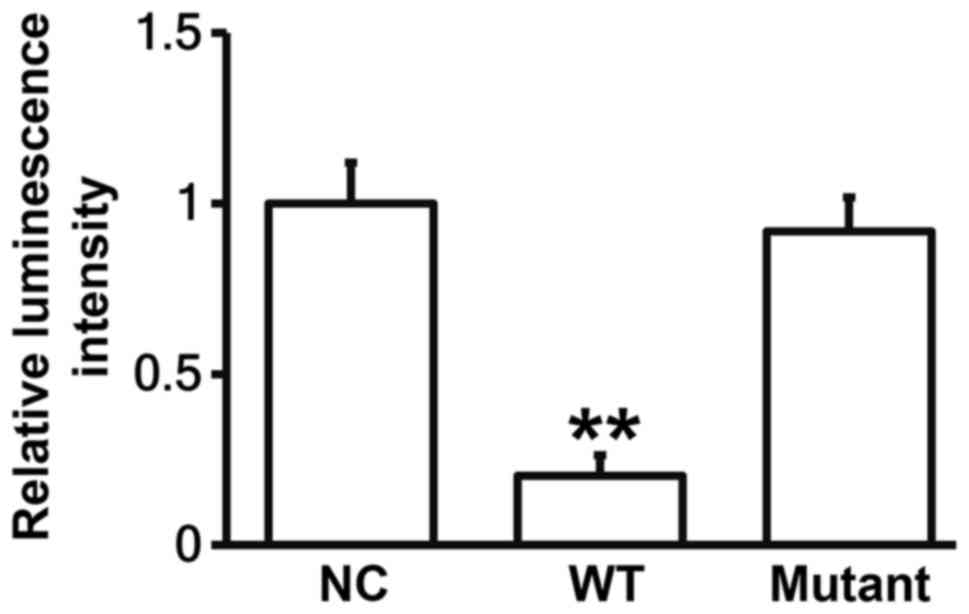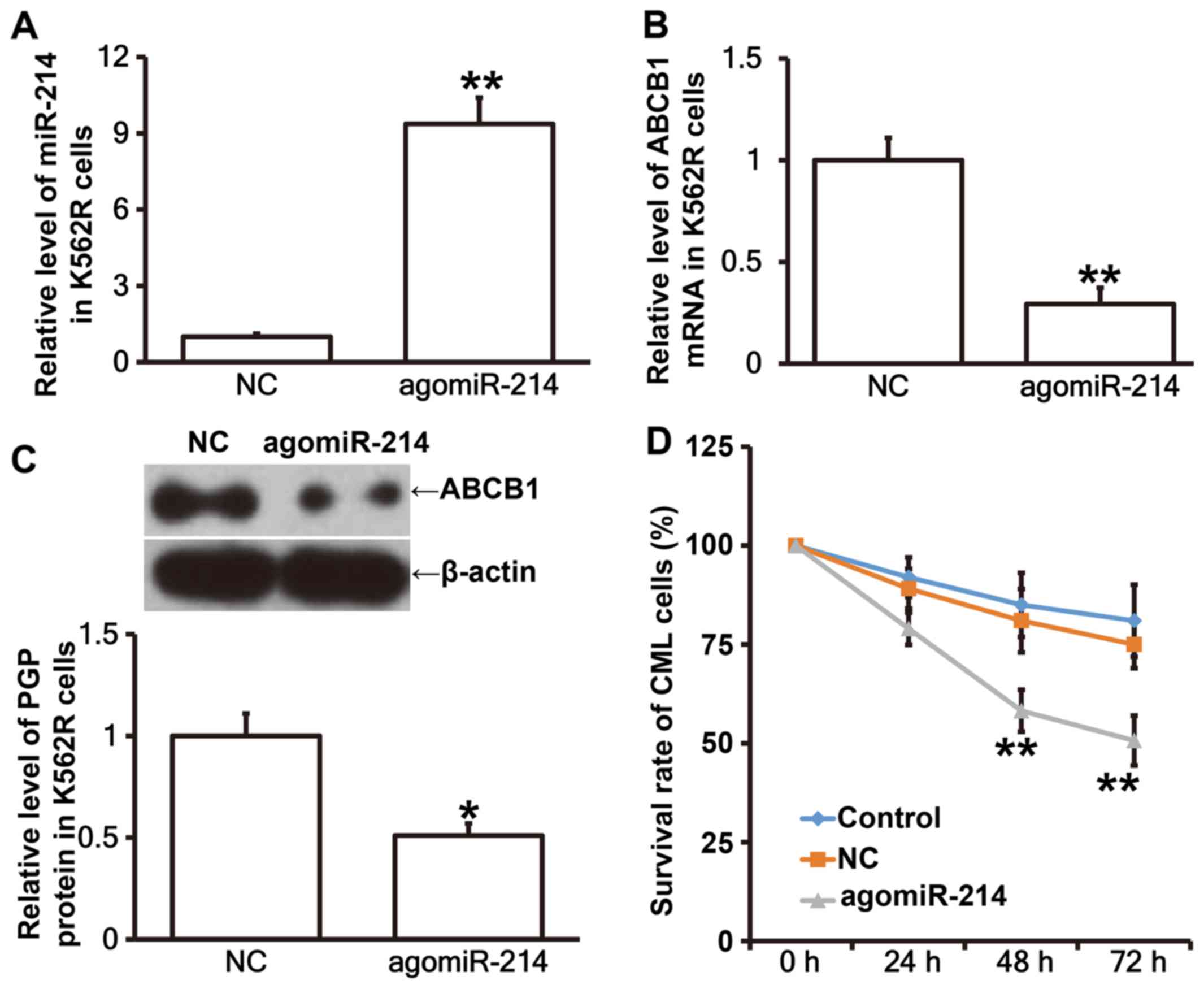|
1
|
Nowell PC: The minute chromosome (Phl) in
chronic granulocytic leukemia. Blut. 8:65–66. 1962. View Article : Google Scholar : PubMed/NCBI
|
|
2
|
Hehlmann R, Hochhaus A and Baccarani M:
European LeukemiaNet: Chronic myeloid leukaemia. Lancet.
370:342–350. 2007. View Article : Google Scholar : PubMed/NCBI
|
|
3
|
Berger U, Maywald O, Pfirrmann M, Lahaye
T, Hochhaus A, Reiter A, Hasford J, Heimpel H, Hossfeld DK, Kolb
HJ, et al: Gender aspects in chronic myeloid leukemia: Long-term
results from randomized studies. Leukemia. 19:984–989. 2005.
View Article : Google Scholar : PubMed/NCBI
|
|
4
|
Wang JX, Huang XJ, Wu DP, Hu JD, Liu T, Hu
Y, Meng FY, Chen XQ, Hou M, Li Y, et al: Overview of chronic
myelogenous leukemia and its current diagnosis and treatment
patterns in 15 hospitals in China. Zhonghua Xue Ye Xue Za Zhi.
30:721–725. 2009.(In Chinese). PubMed/NCBI
|
|
5
|
Cohen MH, Williams G, Johnson JR, Duan J,
Gobburu J, Rahman A, Benson K, Leighton J, Kim SK, Wood R, et al:
Approval summary for imatinib mesylate capsules in the treatment of
chronic myelogenous leukemia. Clin Cancer Res. 8:935–942.
2002.PubMed/NCBI
|
|
6
|
Eskazan AE, Ar MC and Soysal T: Critical
appraisal of European LeukemiaNet (ELN) 2013 recommendations for
the management of chronic myeloid leukemia: Is it early for a
warning? Expert Rev Hematol. 9:919–921. 2016. View Article : Google Scholar : PubMed/NCBI
|
|
7
|
Höglund M, Sandin F, Hellström K, Björeman
M, Björkholm M, Brune M, Dreimane A, Ekblom M, Lehmann S, Ljungman
P, et al: Tyrosine kinase inhibitor usage, treatment outcome, and
prognostic scores in CML: Report from the population-based Swedish
CML registry. Blood. 122:1284–1292. 2013. View Article : Google Scholar : PubMed/NCBI
|
|
8
|
Kantarjian H, O'Brien S, Jabbour E,
Garcia-Manero G, Quintas-Cardama A, Shan J, Rios MB, Ravandi F,
Faderl S, Kadia T, et al: Improved survival in chronic myeloid
leukemia since the introduction of imatinib therapy: A
single-institution historical experience. Blood. 119:1981–1987.
2012. View Article : Google Scholar : PubMed/NCBI
|
|
9
|
Shah NP: Loss of response to imatinib:
Mechanisms and management. Hematology Am Soc Hematol Educ Program.
183–187. 2005.PubMed/NCBI
|
|
10
|
La Rosée P and Hochhaus A: Resistance to
imatinib in chronic myelogenous leukemia: Mechanisms and clinical
implications. Curr Hematol Malig Rep. 3:72–79. 2008. View Article : Google Scholar : PubMed/NCBI
|
|
11
|
Hochhaus A and Hughes T: Clinical
resistance to imatinib: Mechanisms and implications. Hematol Oncol
Clin North Am. 18(641–656): ix2004.
|
|
12
|
Vine J, Cohen SB, Ruchlemer R, Goldschmidt
N, Levin M, Libster D, Gural A, Gatt ME, Lavie D, Ben-Yehuda D and
Rund D: Polymorphisms in the human organic cation transporter and
the multidrug resistance gene: Correlation with imatinib levels and
clinical course in patients with chronic myeloid leukemia. Leuk
Lymphoma. 55:2525–2531. 2014. View Article : Google Scholar : PubMed/NCBI
|
|
13
|
Gromicho M, Dinis J, Magalhães M,
Fernandes AR, Tavares P, Laires A, Rueff J and Rodrigues AS:
Development of imatinib and dasatinib resistance: Dynamics of
expression of drug transporters ABCB1, ABCC1, ABCG2, MVP, and
SLC22A1. Leuk Lymphoma. 52:1980–1990. 2011. View Article : Google Scholar : PubMed/NCBI
|
|
14
|
Mlejnek P, Kosztyu P, Dolezel P, Bates SE
and Ruzickova E: Reversal of ABCB1 mediated efflux by imatinib and
nilotinib in cells expressing various transporter levels. Chem Biol
Interact. 273:171–179. 2017. View Article : Google Scholar : PubMed/NCBI
|
|
15
|
Zhou ZY, Wan LL, Yang QJ, Han YL, Li D, Lu
J and Guo C: Nilotinib reverses ABCB1/P-glycoprotein-mediated
multidrug resistance but increases cardiotoxicity of doxorubicin in
a MDR xenograft model. Toxicol Lett. 259:124–132. 2016. View Article : Google Scholar : PubMed/NCBI
|
|
16
|
Negi LM, Jaggi M, Joshi V, Ronodip K and
Talegaonkar S: Hyaluronan coated liposomes as the intravenous
platform for delivery of imatinib mesylate in MDR colon cancer. Int
J Biol Macromol. 73:222–235. 2015. View Article : Google Scholar : PubMed/NCBI
|
|
17
|
Leslie EM, Deeley RG and Cole SP:
Multidrug resistance proteins: Role of P-glycoprotein, MRP1, MRP2,
and BCRP (ABCG2) in tissue defense. Toxicol Appl Pharmacol.
204:216–237. 2005. View Article : Google Scholar : PubMed/NCBI
|
|
18
|
Graziano A, Monte Lo G, Piva I, Caserta D,
Karner M, Engl B and Marci R: Diagnostic findings in adenomyosis: A
pictorial review on the major concerns. Eur Rev Med Pharmacol Sci.
19:1146–1154. 2015.PubMed/NCBI
|
|
19
|
Jia W, Wu Y, Zhang Q, Gao GE, Zhang C and
Xiang Y: Expression profile of circulating microRNAs as a promising
fingerprint for cervical cancer diagnosis and monitoring. Mol Clin
Oncol. 3:851–858. 2015. View Article : Google Scholar : PubMed/NCBI
|
|
20
|
Jiang XI, Luo Y, Zhao S, Chen Q, Jiang C,
Dai Y, Chen Y and Cao Z: Clinical significance and expression of
microRNA in diabetic patients with erectile dysfunction. Exp Ther
Med. 10:213–218. 2015. View Article : Google Scholar : PubMed/NCBI
|
|
21
|
Zhou H, Li Y, Liu B, Shan Y, Li Y, Zhao L,
Su Z and Jia L: Downregulation of miR-224 and let-7i contribute to
cell survival and chemoresistance in chronic myeloid leukemia cells
by regulating ST3GAL IV expression. Gene. 626:106–118. 2017.
View Article : Google Scholar : PubMed/NCBI
|
|
22
|
Liu L, Wang S, Chen R, Wu Y, Zhang B,
Huang S, Zhang J, Xiao F, Wang M and Liang Y: Myc induced
miR-144/451 contributes to the acquired imatinib resistance in
chronic myelogenous leukemia cell K562. Biochem Biophys Res Commun.
425:368–373. 2012. View Article : Google Scholar : PubMed/NCBI
|
|
23
|
Baccarani M, Saglio G, Goldman J, Hochhaus
A, Simonsson B, Appelbaum F, Apperley J, Cervantes F, Cortes J,
Deininger M, et al: Evolving concepts in the management of chronic
myeloid leukemia: Recommendations from an expert panel on behalf of
the European LeukemiaNet. Blood. 108:1809–1820. 2006. View Article : Google Scholar : PubMed/NCBI
|
|
24
|
Hou J, Lin L, Zhou W, Wang Z, Ding G, Dong
Q, Qin L, Wu X, Zheng Y, Yang Y, et al: Identification of miRNomes
in human liver and hepatocellular carcinoma reveals miR-199a/b-3p
as therapeutic target for hepatocellular carcinoma. Cancer Cell.
19:232–243. 2011. View Article : Google Scholar : PubMed/NCBI
|
|
25
|
Livak KJ and Schmittgen TD: Analysis of
relative gene expression data using real-time quantitative PCR and
the 2(-Delta Delta C(T)) method. Methods. 25:402–408. 2001.
View Article : Google Scholar : PubMed/NCBI
|
|
26
|
Leone G, D'Alò F, Zardo G, Voso MT and
Nervi C: Epigenetic treatment of myelodysplastic syndromes and
acute myeloid leukemias. Curr Med Chem. 15:1274–1287. 2008.
View Article : Google Scholar : PubMed/NCBI
|
|
27
|
Mahon FX, Réa D, Guilhot J, Guilhot F,
Huguet F, Nicolini F, Legros L, Charbonnier A, Guerci A, Varet B,
et al: Discontinuation of imatinib in patients with chronic myeloid
leukaemia who have maintained complete molecular remission for at
least 2 years: The prospective, multicentre Stop Imatinib (STIM)
trial. Lancet Oncol. 11:1029–1035. 2010. View Article : Google Scholar : PubMed/NCBI
|
|
28
|
Cortes J, O'Brien S and Kantarjian H:
Discontinuation of imatinib therapy after achieving a molecular
response. Blood. 104:2204–2205. 2004. View Article : Google Scholar : PubMed/NCBI
|
|
29
|
D'Cunha R, Bae S, Murry DJ and An G: TKI
combination therapy: Strategy to enhance dasatinib uptake by
inhibiting Pgp- and BCRP-mediated efflux. Biopharm Drug Dispos.
37:397–408. 2016. View
Article : Google Scholar : PubMed/NCBI
|
|
30
|
Eadie LN, Dang P, Saunders VA, Yeung DT,
Osborn MP, Grigg AP, Hughes TP and White DL: The clinical
significance of ABCB1 overexpression in predicting outcome of CML
patients undergoing first-line imatinib treatment. Leukemia.
31:75–82. 2017. View Article : Google Scholar : PubMed/NCBI
|
|
31
|
Silva KL, de Souza PS, de Moraes Nestal G,
Moellmann-Coelho A, Fda Vasconcelos C and Maia RC: XIAP and
P-glycoprotein co-expression is related to imatinib resistance in
chronic myeloid leukemia cells. Leuk Res. 37:1350–1358. 2013.
View Article : Google Scholar : PubMed/NCBI
|
|
32
|
Zhou SF: Structure, function and
regulation of P-glycoprotein and its clinical relevance in drug
disposition. Xenobiotica. 38:802–832. 2008. View Article : Google Scholar : PubMed/NCBI
|
|
33
|
Thiebaut F, Tsuruo T, Hamada H, Gottesman
MM, Pastan I and Willingham MC: Cellular localization of the
multidrug-resistance gene product P-glycoprotein in normal human
tissues. Proc Natl Acad Sci USA. 84:7735–7738. 1987. View Article : Google Scholar : PubMed/NCBI
|
|
34
|
Silva R, Vilas-Boas V, Carmo H,
Dinis-Oliveira RJ, Carvalho F, de Lourdes Bastos M and Remião F:
Modulation of P-glycoprotein efflux pump: Induction and activation
as a therapeutic strategy. Pharmacol Ther. 149:1–123. 2015.
View Article : Google Scholar : PubMed/NCBI
|
|
35
|
Fellner S, Bauer B, Miller DS, Schaffrik
M, Fankhänel M, Spruss T, Bernhardt G, Graeff C, Färber L,
Gschaidmeier H, et al: Transport of paclitaxel (Taxol) across the
blood-brain barrier in vitro and in vivo. J Clin Invest.
110:1309–1318. 2002. View Article : Google Scholar : PubMed/NCBI
|
|
36
|
Inoue K: MicroRNA function in animal
development. Tanpakushitsu Kakusan Koso. 52:197–204.
2007.PubMed/NCBI
|
|
37
|
Williams AE, Moschos SA, Perry MM, Barnes
PJ and Lindsay MA: Maternally imprinted microRNAs are
differentially expressed during mouse and human lung development.
Dev Dyn. 236:572–580. 2007. View Article : Google Scholar : PubMed/NCBI
|
|
38
|
Li X, Yu Z, Li Y, Liu S, Gao C, Hou X, Yao
R and Cui L: The tumor suppressor miR-124 inhibits cell
proliferation by targeting STAT3 and functions as a prognostic
marker for postoperative NSCLC patients. Int J Oncol. 46:798–808.
2015. View Article : Google Scholar : PubMed/NCBI
|
|
39
|
Lv ZC, Fan YS, Chen HB and Zhao DW:
Investigation of microRNA-155 as a serum diagnostic and prognostic
biomarker for colorectal cancer. Tumour Biol. 36:1619–1625. 2015.
View Article : Google Scholar : PubMed/NCBI
|
|
40
|
Zhang KC, Xi HQ, Cui JX, Shen WS, Li JY,
Wei B and Chen L: Hemolysis-free plasma miR-214 as novel biomarker
of gastric cancer and is correlated with distant metastasis. Am J
Cancer Res. 5:821–829. 2015.PubMed/NCBI
|
|
41
|
Wang F, Lv P, Liu X, Zhu M and Qiu X:
microRNA-214 enhances the invasion ability of breast cancer cells
by targeting p53. Int J Mol Med. 35:1395–1402. 2015. View Article : Google Scholar : PubMed/NCBI
|
|
42
|
Wang J, Zhang X, Wang L, Yang Y, Dong Z,
Wang H, Du L and Wang C: MicroRNA-214 suppresses oncogenesis and
exerts impact on prognosis by targeting PDRG1 in bladder cancer.
PLoS One. 10:e01180862015. View Article : Google Scholar : PubMed/NCBI
|
|
43
|
Wan DY, Zhang Z and Yang HH:
Cardioprotective effect of miR-214 in myocardial ischemic
postconditioning by down-regulation of hypoxia inducible factor 1,
alpha subunit inhibitor. Cell Mol Biol (Noisy-le-grand). 61:1–6.
2015.PubMed/NCBI
|
|
44
|
Izawa T, Horiuchi T, Atarashi M, Kuwamura
M and Yamate J: Anti-fibrotic role of miR-214 in
thioacetamide-induced liver cirrhosis in rats. Toxicol Pathol.
43:844–851. 2015. View Article : Google Scholar : PubMed/NCBI
|
















